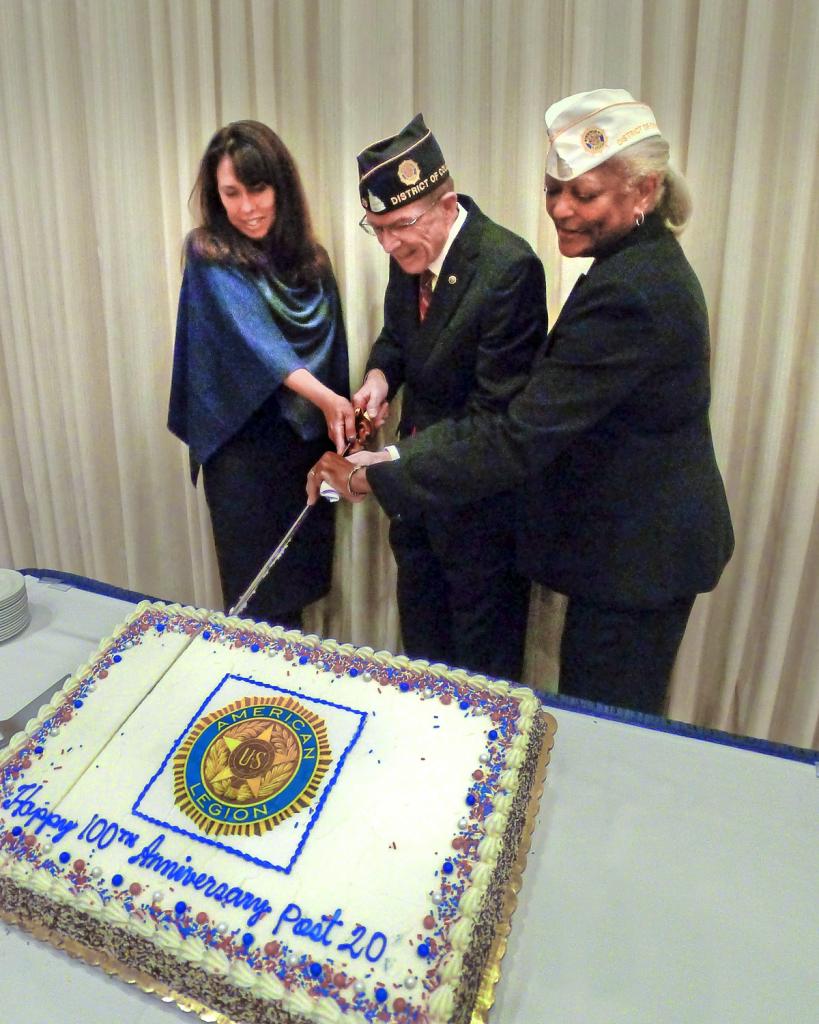Club's American Legion Post celebrates 100 years

National Press Club President Alison Fitgerald Kodjakj (l), American Legion Post 20 Commander Jim Noone and Doranetta Porter, commander of the D.C. Department of the American Legion, cut the post's 100th birthday cake with a naval officer's sword. Photo: Rex Stucky.
With a cake cut by a naval officer’s sword, American Legion Post 20 celebrated its centennial Tuesday evening, Nov. 19.
Post 20, affiliated with the National Press Club for all of the post’s 100 years, received its charter on November 19, 1919. The post was founded at the urging of the most celebrated American commander of World War I. Gen. John “Black Jack” Pershing was an associate Club member. In the same year that Pershing helped found the American Legion, he also suggested a post within the Club.
At the centennial celebration—hosted by the Club—Club President Alison Fitzgerald Kodjak noted that the Club itself is nearly 112 years old. “You’ve been with us just about every step of the way,” Kodjak told Post 20 members and guests.
She also pointed out that the Club represents the core American values of freedom of speech and freedom of the press—and Post 20 represents the core value of service to country. Kodjak’s grandfather, father, and brother served in the Navy.
“Post 20 has a very illustrious history,” former Club president Myron Belkind said. Belkind is a member of Post 20 who spent more than four decades as a foreign correspondent and bureau chief for the Associated Press. He served in the Army in Vietnam as a public affairs specialist.
Belkind said the post’s commanders have included 1961 Club President John Cosgrove. Cosgrove survived eight kamikaze attacks on his destroyer escort during World War II. Cosgrove presented President John F. Kennedy with his Club membership card at Cosgrove’s Club presidential inaugural.
Sarah McClendon was another of Post 20’s commanders. McClendon covered the White House for five decades for her McClendon News Service. She served as a public relations officer for the Women’s Army Corps in World War II.
Post 20 member and 1956 Club President Frank Holeman was an Army counter-intelligence staff sergeant during World War II. Holeman was among the first U.S. occupation troops to land in Honshu in 1945.
Cosgrove, McClendon, and Holeman all have Club rooms named in their honor.
Remarks were also made by Doranetta Porter, commander of the District of Columbia Department of the American Legion. She noted that Post 20 was among the first posts in D.C. to receive a Legion charter.
Post 20’s current commander, retired Navy captain and Vietnam veteran Jim Noone, recounted the American Legion’s legacy. Noone said that after World War I, the Legion demanded a single federal agency to aid veterans. That led to creation of the Veterans’ Bureau, which became the Veterans’ Administration. It is now the Department of Veterans’ Affairs.
Noone also said the Legion pushed for the G.I. Bill, which enabled veterans to get college education and buy homes. The American Legion’s advocacy also helped make Post-Traumatic Stress Disorder a recognized diagnosis.
Noone took a moment to recognize in absentia the post’s most distinguished current member, retired Navy Capt. Jack Crawford. Crawford served aboard the aircraft carrier USS Yorktown during the Battle of Midway. Like the post itself, Crawford recently celebrated his 100th birthday.
In other remarks, Noone described how a program run by Post 20 during World War II led to one of the most iconic photographs of the twentieth century. On Saturday afternoons, Post 20 and the Club held “canteens” for enlisted service members in Washington.
At one of the events, then-Vice President Harry Truman played an upright piano while Hollywood starlet Lauren Bacall lounged atop the instrument. Photos of the event appeared all over the world, including the cover of Life Magazine on May 17, 1945. Almost three-quarters of a century later, that piano holds an honored place in the Club’s Truman Lounge.
The U.S. Army Brass Quintet provided music for the centennial. The Quintet played a medley of military anthems, and members stood as the music represented their own branch of service. Fittingly for the Post 20 event, the Quintet is an element of the U.S. Army Band, known as “Pershing’s Own."
